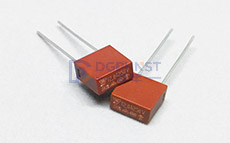Miniature fuse is a miniaturized circuit protection component mainly used in electronic devices to prevent damage caused by overcurrent or short circuit. Its core function is to quickly fuse and cut off the circuit when the current exceeds the rated value, protecting the backend devices. Here is a detailed analysis:

1、 Basic structure and working principle
Physical Structure
Melt material: Low melting point alloys (such as tin, silver, copper alloys) are usually used and encapsulated in ceramic, glass, or polymer shells.
Electrode: Metal terminals at both ends (patch or plug-in), used for soldering on PCB.
Package size: The patch model can be as small as 0402 (1.0mm × 0.5mm), and the plug-in diameter can be as low as φ 5mm.
Job characteristics
Circuit breaking mechanism: When the current is overloaded, the melt heats up to its melting point due to Joule heating, and the circuit is disconnected.
Irreversibility: After melting, a new fuse needs to be replaced (different from the self recovering fuse PPTC).
2、 Core Classification and Technical Parameters
Classified by packaging form
Surface mount (SMD)
Models: 0402, 0603, 1206, etc., suitable for high-density PCB design.
Features: reflow resistant, small size (thickness as low as 0.5mm).
Plug in (Radial/Axial)
Model: 5 × 20mm, 3.6 × 10mm, etc., easy to replace manually.
Features: Resistant to high current impact, with stronger heat dissipation ability.
Classified by melting speed
FastActing: Short response time (millisecond level), suitable for precision circuit protection.
Slow melting type (TimeLag): resistant to momentary surges (such as motor start-up) to avoid accidental triggering.
Key parameters
Rated current (I~n~): 0.1A~30A, to be selected based on 1.5~2 times the operating current.
Rated voltage (V~n~): commonly 32V, 63V, 250V, which should be higher than the maximum voltage of the circuit.
Breaking capacity (I~break~): up to 100A (such as automotive grade fuses).
Temperature characteristics: The working temperature range is usually between 40 ℃ and 125 ℃.
3、 Typical application scenarios
Consumer Electronics
Mobile phones/tablets: protect charging ports and battery packs (such as 0402 patch fuses).
Smart wearable devices: prevent overcurrent in sensor circuits.
Automotive Electronics
Car entertainment system: protects CAN bus and display screen power supply.
BMS (Battery Management System): prevents short circuits in the power battery.
Industrial and Medical Equipment
Industrial control motherboard: Isolation power module failure.
Medical equipment: Ensure safe operation of ECG, monitor, etc.
4、 Selection and usage precautions
Key selection points
Current matching: Select the melting characteristics based on steady-state operating current and pulse current.
Voltage level: It needs to cover the peak voltage of the circuit (such as 250V or above for fuses used in electric vehicles).
Environmental factors: Low rated use is required for high temperature environments, and moisture-proof packaging is preferred for humid environments.
Installation specifications
Surface mount design should avoid mechanical stress, while plug-in design should reserve heat dissipation space.
Avoid parallel use (which may cause uneven current and false tripping).
Certification standards
International certifications: UL/CSA (North America), T Ü V (Europe), AECQ200 (Vehicle Specification).
Environmental requirements: Compliant with RoHS and REACH lead-free standards.
5、 Comparison with self-healing fuses
|Features | Miniature Fuse | Self Recovering Fuse (PPTC)|
|Reset mode | requires manual replacement | automatic recovery (after cooling)|
|Response speed | Faster (millisecond level) | Slower (second level)|
|Internal resistance | Extremely low (m Ω level) | High (Ω level)|
|Cost | Low (single use) | High (repeatable)|
|Applicable scenarios | High precision, irreversible protection | Frequent overcurrent, difficult maintenance scenarios|
Miniature fuses have become the core component of overcurrent protection in modern electronic devices due to their miniaturization, high reliability, and precise protection characteristics. When selecting, it is necessary to comprehensively consider circuit parameters, environmental conditions, and cost factors, and give priority to products that have passed industry certification (such as AECQ200). Under the trend of miniaturization of 5G and IoT devices, their high-density packaging and high temperature resistance will further expand their application scenarios.
